




Return to Table of Contents
Distant, block, and interlocking signal aspects and indications are shown in the special instructions.
Signal aspects are identified by the position of semaphore arms, color of lights, flashing of lights, position of lights, or any combination. Aspects may be qualified by marker plate, number plate, letter plate, or marker light.
Signals may display color light aspects or semaphore arms and color lights.
When viewed from the train, block and interlocking signals are generally to the right of the track. However, they may be located to the left or above the track. To display indications for two tracks, two bracketed signals may be located on a supporting mast. The signal to the right governs the track to the right, and the signal to the left governs the track to the left.

Block signals, cab signals, or both govern the use of blocks.
Interlocking signals govern the use of interlocking routes. Where a track is signaled beyond the interlocking limits in the direction of movement, the interlocking signal is also a block signal.
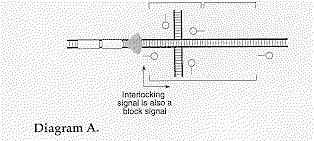 All other rules, where required, remain in effect when
complying with the
indication of block and interlocking signals.
All other rules, where required, remain in effect when
complying with the
indication of block and interlocking signals.
Except as shown in block, cab, and interlocking signal aspects in the special instructions, if a light is absent or a white light is displayed where a colored or lunar light should be, regard a block or interlocking signal as the most restrictive indication that the signal can give. However, when the semaphore arm position is plainly seen, that aspect will govern.
When movement is being made beyond a block signal requiring a train to be prepared to stop at the next signal, the stop must be made before any part of a train passes the block signal requiring the train to stop.
If a train overruns any block signal that requires it to stop, the crew must:
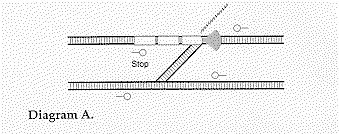
Except to avoid an accident, after a controlled signal has been cleared for a closely approaching train, the control operator must not change the signal before the approaching train's engineer has assured the control operator that he can comply with the signal change. Do not establish or authorize a conflicting route until communicating with the approaching train's crew and ensuring that the train has stopped clear of the conflicting route.
The control operator must not establish a conflicting route into an occupied block or interlocking limits, or authorize a conflicting movement, unless it is safe to do so.
The control operator must avoid operating the device controlling a switch, derail, movable point frog, or lock when any portion of a train is on or closely approaching the equipment.
If a signal or signal appliance functions improperly or the track is damaged, signals that govern movements on affected routes must display a Stop indication. No movements on such routes may be permitted until track and signal appliances are examined and movement can occur safely.
Within CTC limits or within manual interlocking limits (unless track bulletin Form B is in effect), when a switch, movable point frog, derail, or signal is under repair or is disconnected, or when the track is obstructed or removed from service, display Stop indications for all affected routes. In addition, block or mark any controls to prevent their operation.
Maintenance forces must contact the control operator before beginning repairs, disconnecting equipment, obstructing the track, or removing the track from service. Switches, movable point frogs, and derails must be spiked or secured in the required position if any movement over them occurs before repairs are complete.
Except when a signal is used to provide protection within CTC limits or at manual interlockings, control operators must not give hand signals or verbally authorize movement beyond a Stop indication when a proceed indication can be displayed for the movement.
At manual interlockings, control operators must give hand signals so that crew members can understand the signals and know which train they are intended for.
When a controlled signal displays a proceed indication, notify the control operator immediately if movement cannot occur promptly.
Where track occupancy indicators are located, employees must observe the indication before fouling a circuit or changing the derail or a main track switch.
When an occupied indication is displayed, trains or equipment must not foul the main track unless movement is properly protected.
Track occupancy indications do not authorize movement or relieve employees from protecting movements as required by the rules.
If a signal displaying a proceed indication changes to an indication requiring a train to stop, the train must stop at once. Report such a signal change to the train dispatcher.
When a block is occupied, or when a switch protected by a signal is changed from its normal position and that signal fails to display its most restrictive indication, regard the signal as displaying Stop. The train must stop immediately, and employees must warn others by radio of the exact location and status of the train. Contact the train dispatcher or control operator and do not move the train without permission.
A train may comply with the next signal's indication when its aspect can be clearly seen and the signal governs the track where movement is occurring or will be made. This does not apply when a rule or previous signal indication requires movement at restricted speed.
If a train has entered a block on a proceed indication that does not require restricted speed, and the train stops or its speed is reduced below 10 MPH, the train must:
A. ABS
Proceed at restricted speed. The train must maintain this speed until the next signal is visible, that signal displays a proceed indication, and the track to that signal is clear.
 B. CTC or Manual Interlocking Limits
B. CTC or Manual Interlocking Limits
Proceed prepared to stop at the next signal until the next signal is visible and that signal displays a proceed indication.
C. ACS
Operate according to cab signal indication.
A train must proceed prepared to stop at the interlocking signal when:
The train must continue to move prepared to stop at the interlocking signal until the train reaches a point approximately 1,000 feet from that signal. If the interlocking signal then indicates proceed, the train may resume speed.
When one of the following occurs, move at restricted speed until the leading wheels have passed the next governing signal or the end of the block system:
The train enters a block with no governing signal.
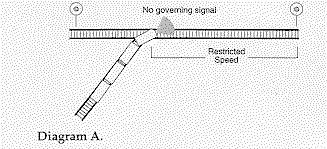
The previous signal indication is unknown. 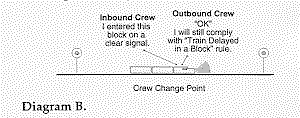
 Exception
Exception
If a train is within ACS territory and a cab signal device is cut in and operative, the train may operate according to the cab signal indication after moving a distance equal to its own length or to the next governing signal.
When a train passes a signal requiring movement at restricted speed, the train must move at restricted speed until its leading wheels have passed the next goveming signal or the end of the block system.
At a signal displaying a Stop indication, if no conflicting movement is evident, the train will be governed as follows:
Exception
Conflicting Movement. When the control operator has stopped a conflicting movement, he may then authorize another train to proceed in the same limits, advising both crews of movement to be made. If the stopped movement is later permitted to proceed, that train must move at restricted speed until its leading wheels have passed the next governing signal or the end of the block system.
At a signal displaying a Stop indication, if no conflicting movement is evident, the train will be governed as follows:
Exception
Conflicting Movement. When the control operator has stopped a conflicting movement, he may then authorize another train to proceed, advising both crews of movements to be made. If the stopped movement is later permitted to proceed, that train must move at restricted speed until its leading wheels have passed the next governing signal or the end of the block system.
At a signal displaying a Stop indication, the crew will be governed by instructions in the release box, special instructions, or other instructions.
If there is a conflicting movement, the train must not proceed until the movement has passed or stopped, and both crews agree on the next movement.
At a signal displaying a Stop indication outside interlocking limits, the train will be governed as follows:
A. Main Track
On a main track, after stopping, a train authorized beyond the signal must comply with one of the following procedures:
B. Siding or Other Track
If the signal governs movements from a siding or other track to the main track, comply with Rule 9.17 (Entering Main Track at Hand-Operated or Spring Switch).
If the control operator cannot line the dual control switch to the desired position, or the control machine does not indicate that the switch is lined and locked, the control operator must authorize movement past the Stop indication and instruct the employee to operate the switch by hand. Movement may then proceed to that switch.
Before passing over the switch, the train must stop and the employee must operate the switch by hand as outlined in Rule 9.13.1 (Hand Operation of Dual Control Switches). After at least one unit or car has passed over the switch points, the employee must return the switch to power unless otherwise instructed by the control operator.
An employee must get permission from the control operator to operate a dual control switch by hand. Operate the switch as follows:
When the selector lever is in the HAND position or the crank has been removed from the holder, signals governing movements over the switch will display Stop indication, and movements will be governed by hand signals. Notify the engineer, if possible, when the switch is in hand operation and when it has been restored to power operation.
On tracks designated in the timetable, trains will run with the current of traffic, if the train dispatcher gives verbal authorization or a controlled signal indicates proceed.
A train without a crew member on the rear and operating on a track having a current of traffic may report clear of the limits or report having passed a specific location only when it is known the train is complete. This must be determined by one of the following ways:
In addition, a train clearing in a siding or other track must comply with requirements outlined in Rule 8.3 (Main Track Switches) before reporting clear of the limits.
On tracks designated in the timetable, a track permit will authorize a train, track car, machine, or employee to occupy the main track or tracks between specific points. The track permit must be issued by a designated control operator under the direction of the train dispatcher. Within these limits, movements may be made in either direction without flag protection.
Except at interlockings, trains granted a track permit, after stopping, may pass a signal displaying a Stop indication to enter limits without further authority.
The track permit may only be issued when:
The track permit limits must be protected by controlled signals. The designated control operator must know the following before issuing a track permit:
Track Permit Wording
Track permits will be granted in the words, "Track permit granted on (track) between (limit) and (limit) until (time)."
The employee requesting a track permit must repeat the permit and receive acknowledgment before acting upon it.
More than One Track Permit
If more than one track permit is in effect at any time within the same limits, all affected trains or employees must be notified.
Trains must move at restricted speed within these limits
Marking or blocking devices must not be removed until the track permit has been released to the control operator. Other movements must not be authorized into the limits unless also granted a track permit.
Track permit limits must be cleared and reported clear to the control operator before time expires. If the track permit is released before time expires, all equipment must be clear of the limits and reported clear to the designated control operator. However, if no other track permit has been granted within the same limits, the train may request release of the track permit. Signal indications will then govern the train if the control operator verbally authorizes the release, specifying direction of movement if required.
The employee must request any additional time before the authorized time has expired. If the employee is not clear when the time expires or if the control operator cannot be contacted, authority is extended until the control operator is contacted.
At a signal displaying a Stop and Proceed indication, the train will be governed as follows:
a. Leave the main track when the switch is
lined for movement and the
track is clear from the signal to the clearance point. 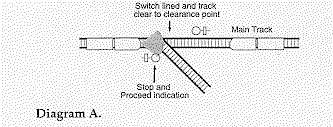
b. Continue on the main track when meeting
or passing a train, and the
main track is clear to the opposite end of the siding where a
train is fouling the main
track. 
c. Permit an engine, with or without cars,
to couple to its train or
to a standing cut of cars, if the track between the engine and
cars is clear. 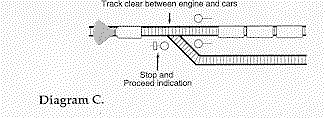
d. Enter a switch that is less than 1,000
feet beyond the signal, and
the employee in charge of the switch has granted permission
for movement. 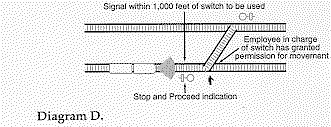
e. Proceed from a Stop indication in CTC
territory, when authorized by
the control operator as prescribed in Rule 9.12.1 (CTC
Territory). This will apply to each
succeeding signal displaying a Stop and Proceed indication.

f. Move within track and time, work and
time, work between, or track
permit limits. 
Within CTC territory and manual interlocking limits, the control operator must authorize the train to enter the main track at a hand-operated or spring switch where no governing signal exists. The control operator must verify that there are no conflicting movements before giving the authority.
In ABS territory, when authorized to enter the main track, a crew member or switch tender must open the switch and wait 5 minutes at the switch to establish block signal protection. If at the end of 5 minutes the employee does not hear or see movement approaching, the train may enter the main track.
A. When Hand Operation of a Spring Switch or 5 Minute Wait Is Not Required
Waiting 5 minutes or operating the spring switch by hand is not required [unless prescribed by Rule 8.9 (Movement over Spring Switches)] under any of the following conditions:
Block signals governing movements on the main
track indicate that no
train is approaching from either direction. 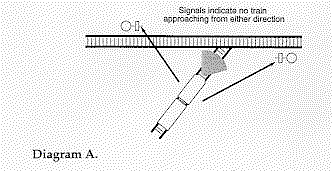
Block to be entered is occupied by a train,
engine, or car that is
standing or moving away from the switch to be used. 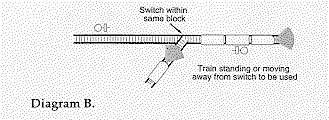
Main track between siding switches is occupied
by a train that has
been met or a standing train that will be passed. 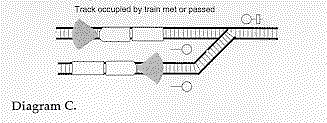
Special instructions or instructions posted near the switch will govern the operation of switches and derails equipped with electric locks.
To enter a main track within interlocking or CTC limits, employees must not open the case door or unlock an electrically locked switch or derail without track and time or authority from the control operator. Emergency Release
If the electric lock includes an emergency release, do not break the seal on the release or operate the release without permission from the control operator or train dispatcher. However, when communication has failed, the seal may be broken and/or the release operated:
Notify the control operator or train dispatcher when the seal has been broken and/or the emergency release operated.
Engines, cars, or equipment must not be detached and left standing entirely between the opposing interlocking signals that govern movements at a railroad crossing at grade.
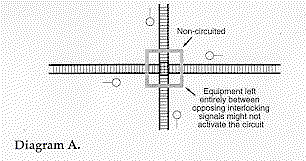
A train, engine, car, or equipment left standing on sidings or other tracks must be clear of insulated joints at clearance points.
Overlaps may be identified by overlap signs. A
train on the main track
at a meeting point must not pass an overlap sign location or open
a switch within the
overlap until the opposing train has entered the block. 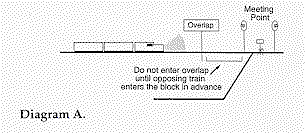 A preceding train must clear the overlap as soon as
possible to avoid
delaying a following train.
A preceding train must clear the overlap as soon as
possible to avoid
delaying a following train.
Do not allow an engine with less than three cars, or cuts of four cars or less, to stand on a sanded rail.
When authorized, a track bulletin may suspend the block system or sections of it.
Do not suspend the block system or sections of it until all trains and control operators in the affected territory have been notified by track bulletin specifying the limits of the suspension.
Track bulletins issued to suspend the block system must not be delivered to trains entering the affected territory until the affected limits are clear of trains, or until the track bulletin has been transmitted or delivered to all trains within the limits.
When the block system or sections of it are suspended, the following guidelines govern:
Trains must approach the block and interlocking signals excepted above and each end of the suspended limits prepared to stop. Trains that leave the limits and move into block system territory must move at restricted speed until they reach the first signal in service beyond the limits. Signals that govern movement over railroad crossings at grade and drawbridges must be regarded as displaying a Stop indication, regardless of the aspect displayed, unless the track bulletin specifies that the signals are in service.
If the crew does not know that signals governing movement over railroad crossings at grade are in service, the crew must provide flag protection in each direction on conflicting routes before proceeding over the crossing. Crew members must not rely on time release or key controller operation as adequate protection while moving over the crossing, unless they are instructed otherwise.
A track bulletin must be issued that specifies which position dual control switches at the end of double track or multiple main tracks are to be left lined.
If a crew member receives notification from the train dispatcher of the position of dual control switches, leave those switches in that position after use.
If spring switches are left in service, trains making facing point movements must be prepared to stop, unless it is known that the switch is properly lined.
When a call light is on, any employee who sees it, unless the employee is on a moving train, must contact the control operator immediately.